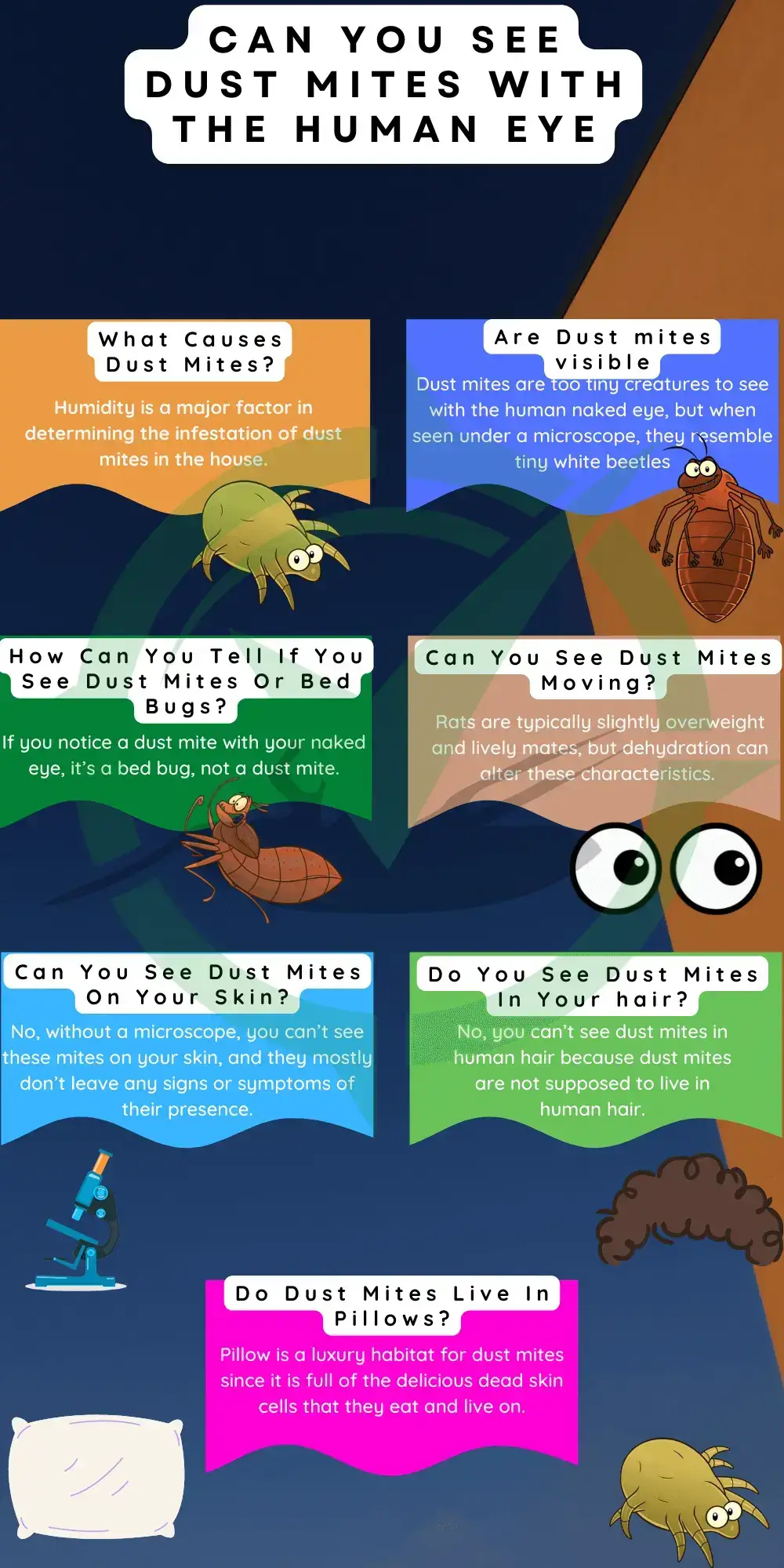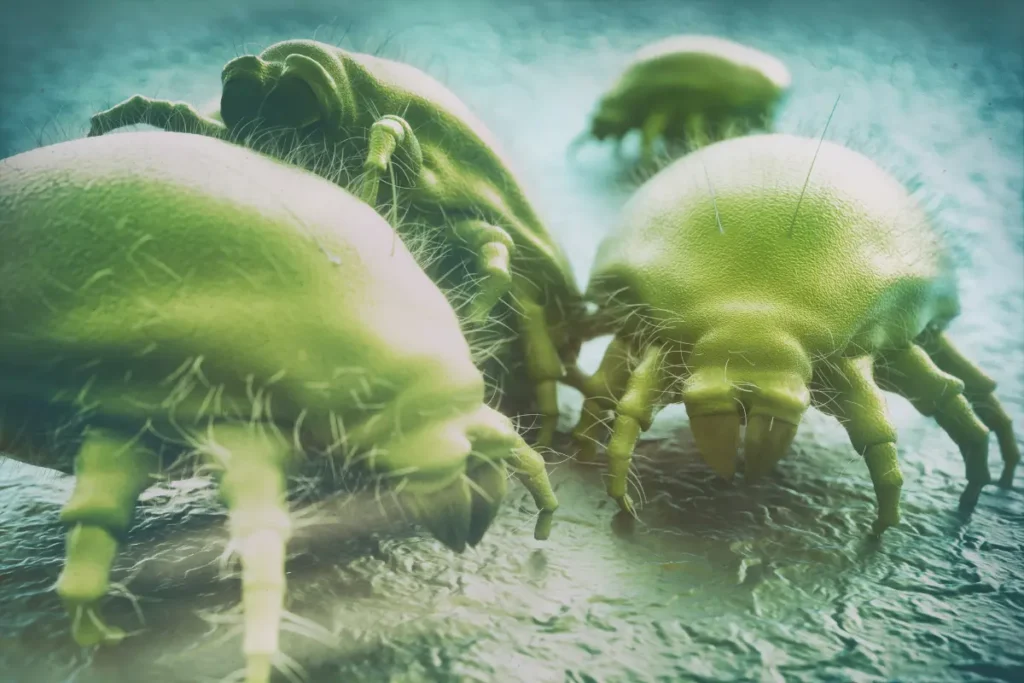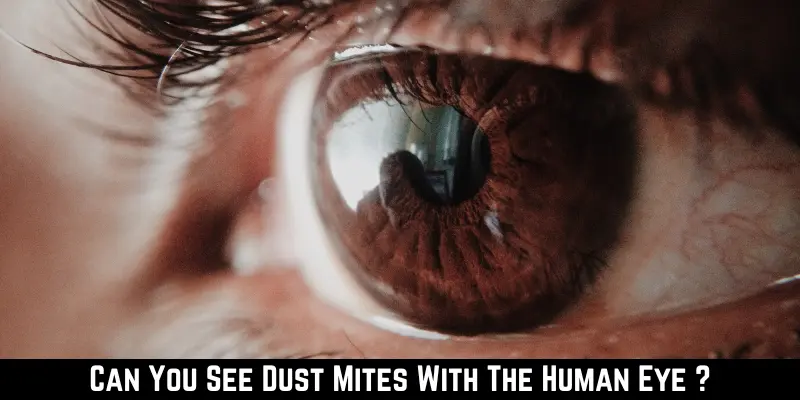Dust in houses is frequently highly polluted with organic waste, primarily from invertebrates. These tiny critters known as dust mites prefer to live in beds. If you have dust mites in your bed, can you see dust mites with the Human Eye?
No, you can’t see the dust mites with the human eye. They are translucent and just 250–300 microns long, making them too small to be seen with the naked eye.
For clear identification, you need at least a 10X magnification power to see house dust mites. So, it´s often nearly impossible to see dust mites in bed. Read the entire article to learn more about dust mites.
What Can You Do to Get Rid of Dust Mites?
Try the following measures to lessen and get rid of dust mites:
- Wash blankets and bed sheets in hot water every month, mainly in humid
- weather.
- As an alternative, you can eliminate your blankets and bed sheets from your
- mattresses by using dust-mite-proof covers.
- To get rid of dust and dead skin, vacuum all the rugs and carpets in the
- house daily.
- You can entirely remove the carpets from your home to prevent dust
- accumulation.
- Curtains should be frequently washed with hot water or replaced with blinds.
- Use leather couches in place of sofas in case of padded sofas.
- Make sure the home’s humidity level is below 50%.
- Use air purifiers with many filters to capture these bed dust mites.
- Spend at least 10-20 minutes ventilating rooms of the house
- Purchase new pillows, mattresses, and bed sheets, at least every 2 years.
- Clothing should be kept in cupboards or plastic bags.
Dust Mites
Dust mites are so tiny that they are related to ticks and spiders. They are commonly known as bed mites, and cannot be seen without a microscope. In warm, humid weather, dust mites grow and feed on human skin cells.
Most homes have carpets, padded furniture, and bedding, all of which provide the ideal living environment for dust mites. A common allergic reaction caused by dust mites is known as a dust mite allergy.
Sneezing and a runny nose are the initial symptoms of dust mite allergy. Many people who have a dust mite allergy also have asthma symptoms, such as wheezing and breathing problems.
An allergy to dust mites might be moderate or severe. When the condition is severe, it may be chronic, causing persistent sneezing, coughing, congestion, facial irritation, a dermatitis flare-up, or a severe asthma attack and respiratory problems.

What Causes Dust Mites?

Dust mites are practically everywhere, especially in humid weather. They are naturally occurring dust organisms that can easily enter houses beds and other indoor spaces due to their tiny size.
According to research by the Asthma and Allergy Foundation of America, humidity is a major factor in determining the infestation of dust mites in the house.
Because the moisture in the air is their primary source of water, dust mites prefer humid environments because they will die in an environment without moisture.
Keep in mind that these small dust mites enjoy humidity. Keep the indoor humidity below 50% by using a dehumidifier to keep dust mites away. The carpet and padded furniture in the home mostly cause allergic irritation.
What Does A Dust Mite Look Like To The Human Eye?
Dust mites are too tiny creatures to see with the human naked eye, but when seen under a microscope, they resemble tiny white beetles with eight legs that are closely related to ticks and spiders. The diameter of dust mites ranges from 0.5–3mm. Bed Dust mites cannot jump or even fly.
Bed Dust Mites have come to have thirteen different species. The American dust mite and the European dust mite are the two most prevalent types of dust mites. It is not a dust mite if people think they can see dust with their naked eyes.
They are round in shape, transparent, colorless creatures. These little pests don’t sting humans. They mostly eat decomposing human tissue like the minute pieces of skin that people naturally shed each day, especially on their beds.
An adult will typically expel up to 1 gram of skin daily, which is sufficient to feed one million bed dust mites.
How Can You Tell If You See Dust Mites Or Bed Bugs?
Both bed bugs and bed dust mites are unappealing creatures that share several of the same characteristics. The bedbugs are ten times smaller than the bed dust mites, so the human eye cannot see dust mites.
Since you can only see them under a microscope, if you notice a dust mite with your naked eye, it’s a bed bug, not a dust mite.
Furthermore, spherical dust mites have a translucent white appearance, while young bed bugs, are translucent yellow at first but become crimson as soon as they start consuming blood.
They have oval, flat frames, and a brownish tint as they grow. But once more, they lengthen and turn a rich crimson color after a good feed.
Dead skin cells make up dust mites’ food, but bed bugs didn’t eat dead skin flakes. Although they can land on the skin to feed, the bugs often find food on floors and in carpets.
Can You See Dust Mites Moving?
Yes, you can see the dust mites while moving, but under the electron microscope, not with the human naked eye. Dust mites only appear to be little, white, transparent spider-like animals when viewed under a microscope.
Male dust mites have a lifespan of over one month almost, and females have a lifespan of up to 90 days barely. Dust mites feed on dead skin cells, which is why they are so commonly found on beds and padded furniture.
One human loses almost 1.5 grams of dead skin cells every day, which can provide up to one million dust mites with food.
Dust mites live in beds, furniture like sofas, and carpeting where dead skin cells are easiest to collect. Dust mites also enjoy living on rugs and plush toys.
Can You See Dust Mites On Your Skin?

No, without a microscope, you can’t see these mites on your skin, and they mostly don’t leave any signs or symptoms of their presence. However, sometimes they may be the reason you can tell if you have dust mites on your skin or not.
Inhaling the skin and feces of dust mites can cause different allergic reactions, which are common and give you the sign of having dust mites on your skin. An allergy to dust mites may cause many symptoms all year long. Some of the symptoms are:
Postnasal drip, coughing, sneezing, runny or stuffy nose, itchy skin, watery eyes, redness, sore throat dust mite allergies may cause asthma, depending on how severe they are.
As a result, people can experience chest pain, coughing, and wheezing. When lying down at night, sometimes symptoms can be severe. People are more susceptible to dust mite problems the more time they spend indoors.
Do You See Dust Mites Live In Your Hair?

No, you can’t see dust mites in human hair because dust mites are not supposed to live in human hair. Human facial hair follicles are usually home to hair mites like Demodex folliculorum, also known as the hair follicle mite. The human neck, or chest, is where Demodex Brevis typically lives.
These mites are also invisible to the naked eye and visible under an electron microscope and frequently do not leave any signs and symptoms. But for some individuals, they could result in irritated, scaly skin; and redness, Greater sensitivity to the sun scorching on the skin that feels like sandpaper.
If the human immune system is weak, these people are more susceptible to experiencing skin problems and other symptoms of hair mites than those with a strong immune system.
Additionally, according to some studies, greater levels of Demodex are found in pre-existing face skin disorders like acne, androgenic alopecia, or facial eczema.
Do You See Dust Mites Live In Pillows?

A pillow is a luxury habitat for dust mites since it is full of the delicious dead skin cells that they eat and live on. Spring and summer are two of a dust mite’s favorite seasons as heat and humidity are the only things they enjoy more than skin cells.
A single gram of dust can support hundreds of dust mites, while most are invisible to human sight. Dust mites are common, as they prefer hot and humid areas because they cannot survive in dry environments.
They can move with people when they relocate or go on a holiday or business trip since they can scurry deep into cloth fibers. People should wash pillows to keep dust mites away. To get rid of dust, sweat, and saliva stains, wash pillows at least twice or three times a year and more frequently for people with dust allergies.
Conclusion
Dust mites are common around the world, but they seem to prefer hot and humid areas because they did not survive in dry environments. Dust mites are poor housemates.
Without an electron microscope, it is impossible to see dust mites in the human eye, which are so tiny that they are linked to ticks and spiders and are also known as bed mites. Dust mites grow and eat the skin cells of humans in warm, humid climates. To identify house dust mites, you need a magnification level of at least 10X. Some disinfectants such as Dr. Zym are effective to kill spider mites.
Most houses include carpets, upholstered furniture, and bedding, which provide the ideal living environment for dust mites. A dust mite allergy is a typical allergic reaction brought on by dust mites. Dust mites are nearly impossible to entirely eradicate from homes, but you can lessen their population by using the few tips explained above.
References
Jeffrey M. Wilson, Thomas A.E. Platts-Mills, Home Environmental Interventions for House Dust Mite, The Journal of Allergy and Clinical Immunology: In Practice, Volume 6, Issue 1, 2018
Wilson JM, Platts-Mills TAE. Home Environmental Interventions for House Dust Mite. J Allergy Clin Immunol Pract. 2018 Jan-Feb;6(1):1-7. doi: 10.1016/j.jaip.2017.10.003. PMID: 29310755; PMCID: PMC6474366.



